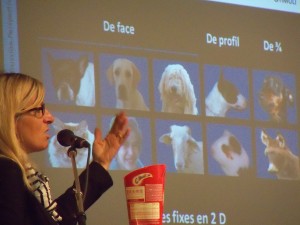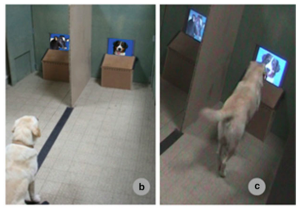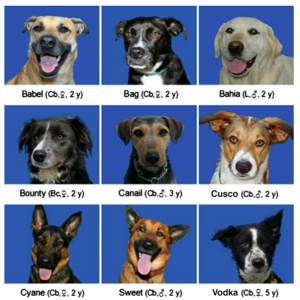Have you ever considered sending a picture of yourself to your beloved dog while he’s waiting for your return from vacation? Most of us would probably not think of this as anything meaningful to the dog. Yet, research is now showing that dogs are very capable of recognizing people from their picture alone.
 At the last MFEC conference, in France, Dr. Autier-Derian, veterinarian/ethologist, exposed how when asked to chose between two pictures, dogs are capable of consistently heading towards the pictures of the people they know versus those of strangers.
At the last MFEC conference, in France, Dr. Autier-Derian, veterinarian/ethologist, exposed how when asked to chose between two pictures, dogs are capable of consistently heading towards the pictures of the people they know versus those of strangers.
By conditioning the animals to go to a specific category of images, scientist can then show them many different images and measure how often they go towards those belonging to the categories they have learned. Previous studies on pigeons have shown that they can be taught to recognize different shapes then indicate when they see them again amongst other objects. Pigeons are capable of distinguishing up to 150 different objects, but also classify images according to whether humans were present in them or not. Social animals have proven capable of learning to distinguish between categories such as: belonging to the same species, different age groups or social ranks. They need to know which individuals belong to their species and group. My African Grey parrot for instance, will call all dogs by the same name, my own dog Nala of course, but also the many other visiting dogs, but won’t ever call the cats with that name.

The dog is presented with two pictures as he sits on the black line in front of the experimenter. When given a cue, he goes towards the chosen picture and places one of his paws in front of it.
When we see a person, we often only see a small portion of them, or see them at a particular angle, yet we’re still capable of recognizing them. Dr. Autier-Derian’s group wanted to see if dogs could recognize other dogs regardless of breeds and conditions but also if they could distinguish humans from non humans and familiar humans from strangers.
After an initial training period where the dogs are rewarded for choosing pictures from a certain group, they were presented with different categorization tasks. The results showed that dogs are capable of choosing images of dogs over other animals, regardless of the extreme variability between breeds. Even without extra training, when they had a chance to interact with other dogs for less than a month, they were also capable of picking pictures of those dogs amongst those of strange dogs. There was no difference in their success rate when only presented face or body pictures alone and at different angles.
But dogs aren’t just good at figuring out pictures of other dogs, they’re just as efficient when it comes to comparing between pictures of humans versus other animals, or between familiar and non-familiar human faces. Most studies on perceptive abilities in dogs have focused on olfaction, but even though their visual acuity is rather poor compared to people and is mostly based on movement detection, they still tend to use that ability a whole lot more than we think. It makes sense since visual information is much easier to use and readily available in most daily activities. The change in the dog’s body language when analyzing smell is a good indicator of the difference in use of those two senses.
So next time the dog looks at you, know that he’s mostly focused on your eyes and mouth and that, based on that information alone, he’ll be able to recognize you amongst any other animal or human. In your dog’s eyes, you’ll always be in a category of your own!
Jennifer Cattet, Ph.D.
Dominique Autier-Dérian, Bertrand L. Deputte, Karine Chalvet-Monfray, Marjorie Coulon, Luc Mounier. Visual discrimination of species in dogs (Canis familiaris).Animal Cognition, 2013; DOI: 10.1007/s10071-013-0600-8



Here is another study demonstrating how well dogs do reading humans.. http://www.huffingtonpost.com/2012/01/05/dogs-human-expressions_n_1186639.html
Interesting study looking at the connection between the owners voice and a picture… http://dogbehaviorscience.wordpress.com/2013/03/15/when-a-dog-hears-your-voice-he-also-sees-your-face/
Just wondering if this type of recognition would in any way help dogs with separation anxiety??
Since this is new information, there are no scientific studies that would help answer that yet. Dogs can calm down when given items from their owner, like a worn T-shirt that they can lie on, so it’s possible that a picture could also help. You bring up an interesting point that would certainly be worth trying. Please let us know if you do.
Jennifer
Why do dogs bark when they lock at themselves in a mirror? Could it be that they can´t recognize the dog in the mirror? (never barks at dogs they know)
Great post- fascinating!